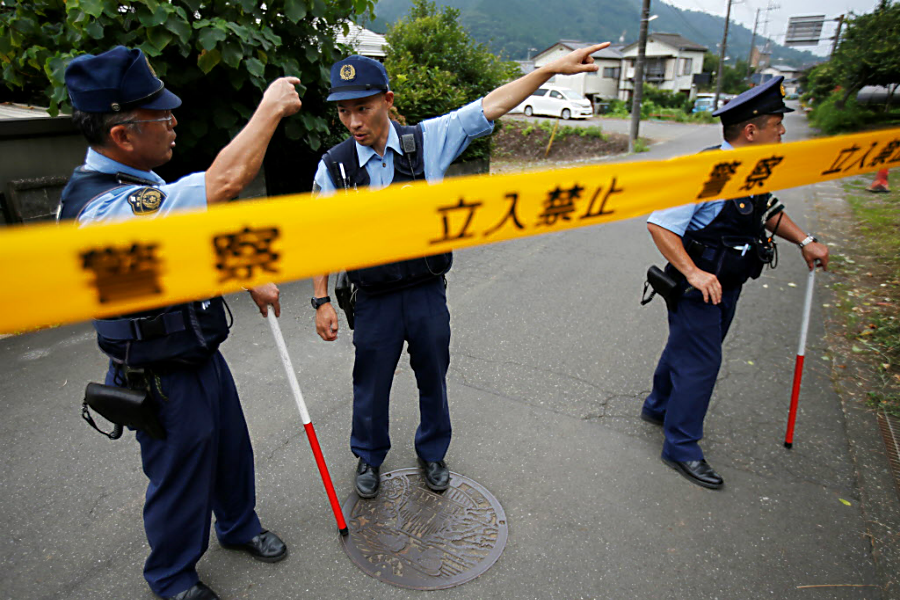Could the mass stabbing in Japan have been prevented?
Loading...
The stabbing rampage early Tuesday at a facility for disabled peopled outside of Tokyo has stunned Japan, and not just because it is the deadliest mass murder in the country since World War II. The 26-year-old man who confessed to the killings also left a trail of warning signs for law enforcement and friends as early as February.
This winter, Satoshi Uematsu delivered a letter to the home of the speaker of the lower house of Japanese parliament that laid out his plan to kill hundreds of disabled people “for the sake of Japan,” starting with two care centers, including the one he broke into on Tuesday. He also urged legal changes to allow the severely disabled to be euthanized, according to NHK, the Japanese Broadcasting Corporation, as The New York Times reported.
Tuesday’s rampage highlights Japan’s low murder rate, credited, in part, to the country’s strict gun laws. Yet, it also exposes the country’s attitudes, treatment, and stigmatization of mental illnesses, from depression to delusional disorders.
Michael Gillan Peckitt, a philosophy lecturer at Osaka University and an expert on disabled people's issues in Japan, said the attack speaks more about Mr. Uematsu than the treatment of the disabled in Japan.
"It highlights the need for an early-intervention system in the Japanese mental health system," Dr. Peckitt told the Associated Press. "Someone doesn't get to that state without some symptoms of mental illness."
Uematsu admitted to the killings just hours after the attack at the Tsukui Yamayuri-en facility in Sagamihara, about 30 miles west of Tokyo. The mass murder occurred at about 2 a.m. Armed with a bag of knives, Uematsu said he methodically slit the throats of patients, killing 19, and wounding dozens more.
Two hours later, he calmly turned himself in to a nearby police station, saying that “all the handicapped should disappear.”
Compared to the United States, Japan has almost never experienced a rampage this large or vicious. The last mass murder in Japan was in 2008, when an autoworker drove a rental truck into a crowd of pedestrians and attacked passersby with a knife, killing seven. In 1995, the Aum Shinkrikyo cult released sarin gas on the Tokyo subway, killing 13 and sickening thousands more.
The murder rate in Japan is one of the lowest in the world. Less than one person is murdered for every 100,000, the second lowest in the OECD behind Luxembourg. Japan’s rate is often attributed to its strict gun control (there are 0.6 privately-owned guns per 100 people), and a relatively stable, economically comfortable society, with low levels of inequality. But Tuesday’s rampage has also put Japanese stigma of mental illness, and its treatment, in relief.
The picture being painted of Uematsu is of a deeply troubled man who didn’t hide his belief that disabled people should be killed and euthanized. In the letter he delivered to the home of the speaker of the lower house of parliament on Feb. 15, Uematsu wrote that killing disabled people is a public service. He asked he be judged innocent on grounds of insanity, and be given $5 million and plastic surgery, so he could live a normal life afterward.
The next day, he was committed to a psychiatric hospital. Marijuana was found in his urine, and he was diagnosed with marijuana-induced psychosis and a delusional disorder. But on March 2, doctors found that Uematsu’s symptoms had disappeared, concluded he was not a danger to others, and released him.
In 2002, The New York Times offered a window into how some Japanese people viewed mental illness, sometimes viewed through a lens of character, rather than as medical conditions – views some analysts say have changed, but not entirely:
Many experts say the biggest barrier to treatment is the sense of shame about psychological conditions, which some liken to the way depression was whispered about darkly in the United States in the 1950's, in the era of shock therapy.
When Japanese experience depression, doctors say, they prefer to imagine something is wrong with their character rather than their heads, and a cultural impulse known as ''gaman,'' or the will to endure, takes precedence over medical care.
''In a culture of shame, the only thing to do about illnesses of the mind is to hide them,'' Dr. [Tadashi] Onda [a Tokyo psychiatrist] said. ''They still carry a stigma here that can haunt families down through the generations. The best parallel I can imagine is the war, when tens of thousands of Japanese soldiers preferred dying in hopeless circumstances rather than surrendering – because of the power of shame.''
Much of Japan has warmed to psychological treatment since then, according to BBC. However, the more severe a mental disorder, the stronger a stigma has remained, according to a 2013 study published in Psychiatry and Clinical Neurosciences.
The study, led by Shuntaro Ando of the Tokyo Metropolitan Institute of Medical Science, also found those diagnosed with mental health disorders were more likely to be institutionalized.
Stephen Murphy-Shigematsu, a California-based psychologist who was a professor at the University of Tokyo, says the country also has a long history of institutionalizing those with any kind of disability, mental or physical. In a phone interview with The Christian Science Monitor Tuesday, he says it's possible the country's negative perception about disabled people could have contributed to Uematsu’s delusional beliefs.
But Dr. Murphy-Shigematsu hopes that a horrific crime like this can lead to disabled people generally becoming more accepted, "less stigmatized, and more integrated into society."
This report contains material from the Associated Press.







